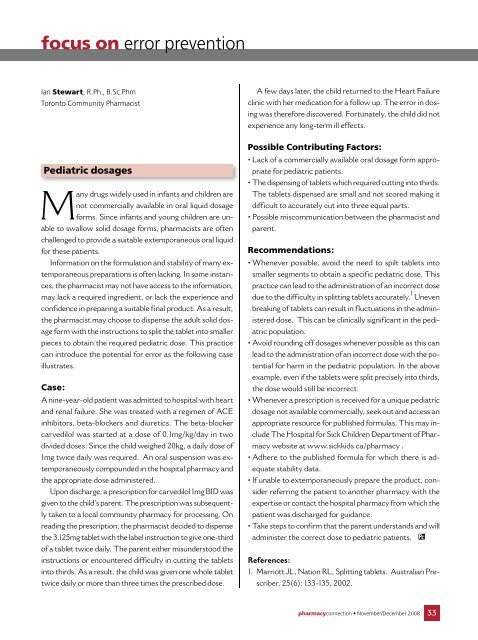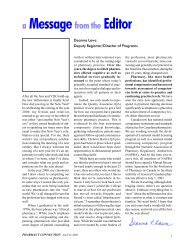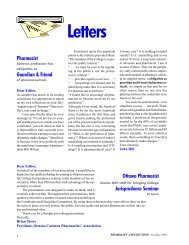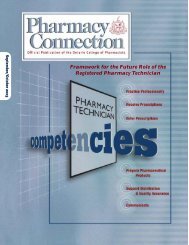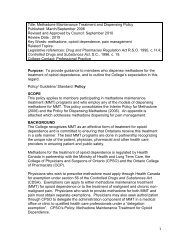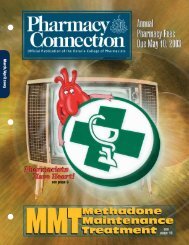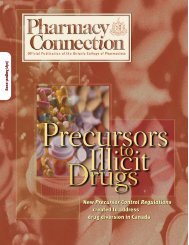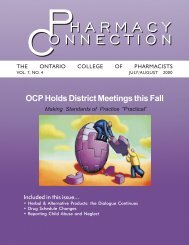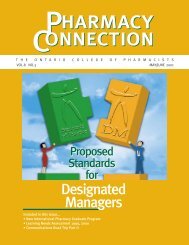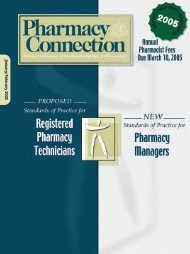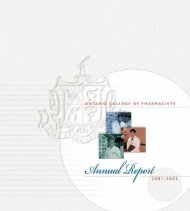November/December 2008 - Ontario College of Pharmacists
November/December 2008 - Ontario College of Pharmacists
November/December 2008 - Ontario College of Pharmacists
Create successful ePaper yourself
Turn your PDF publications into a flip-book with our unique Google optimized e-Paper software.
focus on error prevention<br />
Ian Stewart, R.Ph., B.Sc.Phm<br />
Toronto Community Pharmacist<br />
A few days later, the child returned to the Heart Failure<br />
clinic with her medication for a follow up. The error in dosing<br />
was therefore discovered. Fortunately, the child did not<br />
experience any long-term ill effects.<br />
Pediatric dosages<br />
Many drugs widely used in infants and children are<br />
not commercially available in oral liquid dosage<br />
forms. Since infants and young children are unable<br />
to swallow solid dosage forms, pharmacists are <strong>of</strong>ten<br />
challenged to provide a suitable extemporaneous oral liquid<br />
for these patients.<br />
Information on the formulation and stability <strong>of</strong> many extemporaneous<br />
preparations is <strong>of</strong>ten lacking. In some instances,<br />
the pharmacist may not have access to the information,<br />
may lack a required ingredient, or lack the experience and<br />
confidence in preparing a suitable final product. As a result,<br />
the pharmacist may choose to dispense the adult solid dosage<br />
form with the instructions to split the tablet into smaller<br />
pieces to obtain the required pediatric dose. This practice<br />
can introduce the potential for error as the following case<br />
illustrates.<br />
Case:<br />
A nine-year-old patient was admitted to hospital with heart<br />
and renal failure. She was treated with a regimen <strong>of</strong> ACE<br />
inhibitors, beta-blockers and diuretics. The beta-blocker<br />
carvedilol was started at a dose <strong>of</strong> 0.1mg/kg/day in two<br />
divided doses. Since the child weighed 20kg, a daily dose <strong>of</strong><br />
1mg twice daily was required. An oral suspension was extemporaneously<br />
compounded in the hospital pharmacy and<br />
the appropriate dose administered.<br />
Upon discharge, a prescription for carvedilol 1mg BID was<br />
given to the child’s parent. The prescription was subsequently<br />
taken to a local community pharmacy for processing. On<br />
reading the prescription, the pharmacist decided to dispense<br />
the 3.125mg tablet with the label instruction to give one-third<br />
<strong>of</strong> a tablet twice daily. The parent either misunderstood the<br />
instructions or encountered difficulty in cutting the tablets<br />
into thirds. As a result, the child was given one whole tablet<br />
twice daily or more than three times the prescribed dose.<br />
Possible Contributing Factors:<br />
• Lack <strong>of</strong> a commercially available oral dosage form appropriate<br />
for pediatric patients.<br />
• The dispensing <strong>of</strong> tablets which required cutting into thirds.<br />
The tablets dispensed are small and not scored making it<br />
difficult to accurately cut into three equal parts.<br />
• Possible miscommunication between the pharmacist and<br />
parent.<br />
Recommendations:<br />
• Whenever possible, avoid the need to spilt tablets into<br />
smaller segments to obtain a specific pediatric dose. This<br />
practice can lead to the administration <strong>of</strong> an incorrect dose<br />
due to the difficulty in splitting tablets accurately. 1 Uneven<br />
breaking <strong>of</strong> tablets can result in fluctuations in the administered<br />
dose. This can be clinically significant in the pediatric<br />
population.<br />
• Avoid rounding <strong>of</strong>f dosages whenever possible as this can<br />
lead to the administration <strong>of</strong> an incorrect dose with the potential<br />
for harm in the pediatric population. In the above<br />
example, even if the tablets were split precisely into thirds,<br />
the dose would still be incorrect.<br />
• Whenever a prescription is received for a unique pediatric<br />
dosage not available commercially, seek out and access an<br />
appropriate resource for published formulas. This may include<br />
The Hospital for Sick Children Department <strong>of</strong> Pharmacy<br />
website at www.sickkids.ca/pharmacy .<br />
• Adhere to the published formula for which there is adequate<br />
stability data.<br />
• If unable to extemporaneously prepare the product, consider<br />
referring the patient to another pharmacy with the<br />
expertise or contact the hospital pharmacy from which the<br />
patient was discharged for guidance.<br />
• Take steps to confirm that the parent understands and will<br />
administer the correct dose to pediatric patients.<br />
References:<br />
1. Marriott JL, Nation RL, Splitting tablets. Australian Prescriber,<br />
25(6): 133-135, 2002.<br />
pharmacyconnection • <strong>November</strong>/<strong>December</strong> <strong>2008</strong><br />
33


